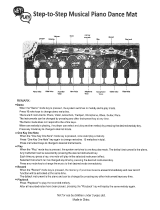
PSR-E403/YPT-400 Owner’s Manual
9
Copyright Notice .................................................................... 6
Panel Logos ........................................................................... 6
Accessories............................................................................ 7
Special Features of the PSR-E403/YPT-400......................... 8
Setting Up 10
Power Requirements ........................................................... 10
Connecting Headphones (PHONES/OUTPUT Jack)........... 11
Connecting a Footswitch (SUSTAIN Jack) .......................... 11
Connecting to a Computer (USB Terminal) ......................... 11
Turning the Power On.......................................................... 11
Panel Controls and Terminals 12
Front Panel .......................................................................... 12
Rear Panel ........................................................................... 13
Quick Guide
Creating Arpeggios 14
Create Original Sounds 18
Assigning Effects to the Knobs ............................................ 18
Using the Knobs................................................................... 21
The Easy Way to Play Piano 23
Play with Both Hands........................................................... 23
Change the Song Tempo..................................................... 27
Try Playing a Variety of Instrument Voices 28
Select and Play a Voice—MAIN .......................................... 28
Play Two Voices Simultaneously—DUAL............................ 29
Play Different Voices with the Left and Right Hands
—SPLIT .......................................................................... 30
Play the Grand Piano Voice................................................. 31
Fun Sounds 32
Drum Kits ............................................................................. 32
Sound Effects....................................................................... 32
Playing Styles 33
Select a Style Rhythm.......................................................... 33
Play Along with a Style ........................................................ 34
Playing Auto-accompaniment Chords.................................. 38
Using Songs 39
Select and Listen to a Song ................................................. 39
Song Fast Forward, Fast Reverse, and Pause.................... 40
Types of Songs .................................................................... 42
Select a Song For a Lesson 43
Lesson 1—Waiting............................................................... 43
Lesson 2—Your Tempo ....................................................... 46
Lesson 3—Minus One ......................................................... 47
Practice Makes Perfect—Repeat and Learn........................ 48
Play Using the Music Database 49
Change a Song’s Style 50
Listen to the DEMO Song for Easy Song Arranger.............. 50
Using the Easy Song Arranger ............................................ 50
Record Your Own Performance 52
Track Configuration.............................................................. 52
Recording Procedure ........................................................... 52
Song Clear—Deleting User Songs ...................................... 55
Track Clear—Deleting a Specified Track
from a User Song............................................................ 55
Backup and Initialization 56
Backup ................................................................................. 56
Initialization .......................................................................... 56
Basic Operation and Displays 57
Basic Operation ................................................................... 57
Display Items ....................................................................... 59
Reference
Adding Effects 60
Harmony...............................................................................60
Adding Reverb .....................................................................61
Adding Chorus .....................................................................62
Handy Performance Features 63
The Metronome.................................................................... 63
Setting the Number of Beats per Measure,
and the Length of Each Beat ..........................................64
Adjusting the Metronome Volume........................................64
Tap Start ..............................................................................65
Touch Response Sensitivity................................................. 65
Pitch Bend............................................................................ 66
Pitch Controls....................................................................... 66
Controlling Arpeggio Volume with Keyboard Dynamics....... 67
One Touch Setting ...............................................................68
Adjusting the Harmony Volume............................................69
Select an EQ Setting for the Best Sound.............................69
Style (Auto-accompaniment) Functions 70
Pattern Variation (Sections) .................................................70
Adjusting the Style Volume ..................................................72
Setting the Split Point........................................................... 72
Play a Style with Chords but No Rhythm
(Stop Accompaniment) ...................................................73
Loading Style Files............................................................... 74
Chord Basics........................................................................ 75
Looking Up Chords Using the Chord Dictionary ..................77
Song Settings 78
Song Volume........................................................................78
A-B Repeat...........................................................................78
Muting Independent Song Parts...........................................79
Change the Melody Voice....................................................79
Memorize Your Favorite Panel Settings 80
Saving to the Registration Memory......................................80
Recalling a Registration Memory .........................................81
The Functions 82
Selecting and Setting Functions...........................................82
Connecting to a Computer 85
What Is MIDI? ......................................................................85
Connecting a Personal Computer........................................86
Transferring Performance Data to and from a Computer.....87
Remote Control of MIDI Devices..........................................88
Initial Send ...........................................................................89
Transferring Data between the Computer and Instrument... 89
Accessory CD-ROM Installation Guide 92
Important Notices about the CD-ROM .................................92
CD-ROM Contents...............................................................93
System Requirements.......................................................... 94
Software Installation............................................................. 94
Appendix
Troubleshooting................................................................. 99
Scores ............................................................................... 100
Voice List .......................................................................... 106
Drum Kit List .................................................................... 110
Style List ........................................................................... 112
Arpeggio List ................................................................... 113
Music Database List ........................................................ 114
Songs Provided On the Supplied CD-ROM ................... 116
Effect Type List ................................................................ 117
MIDI Implementation Chart ............................................. 118
MIDI Data Format ............................................................. 120
Specifications................................................................... 121
Index.................................................................................. 122
Contents




















